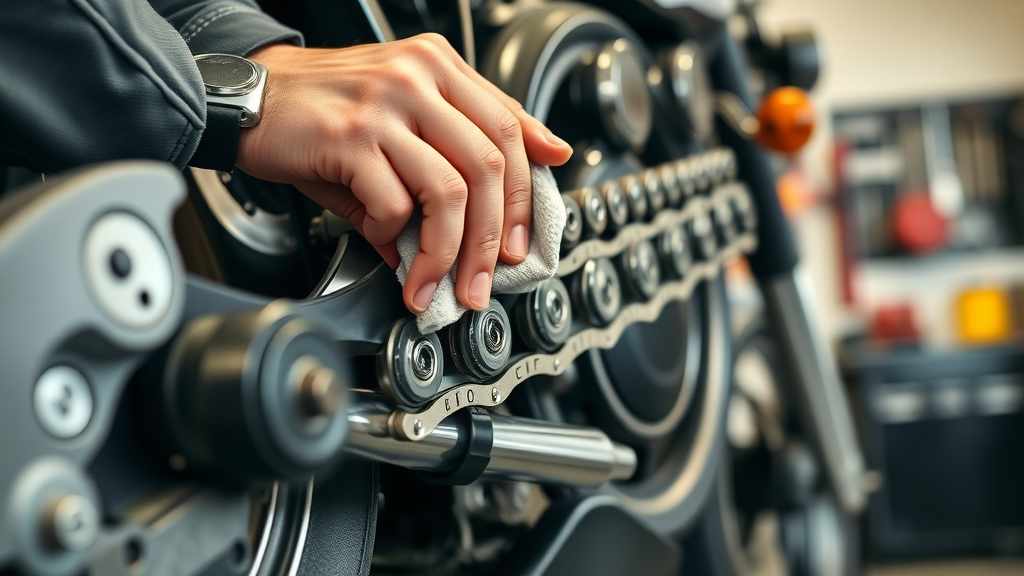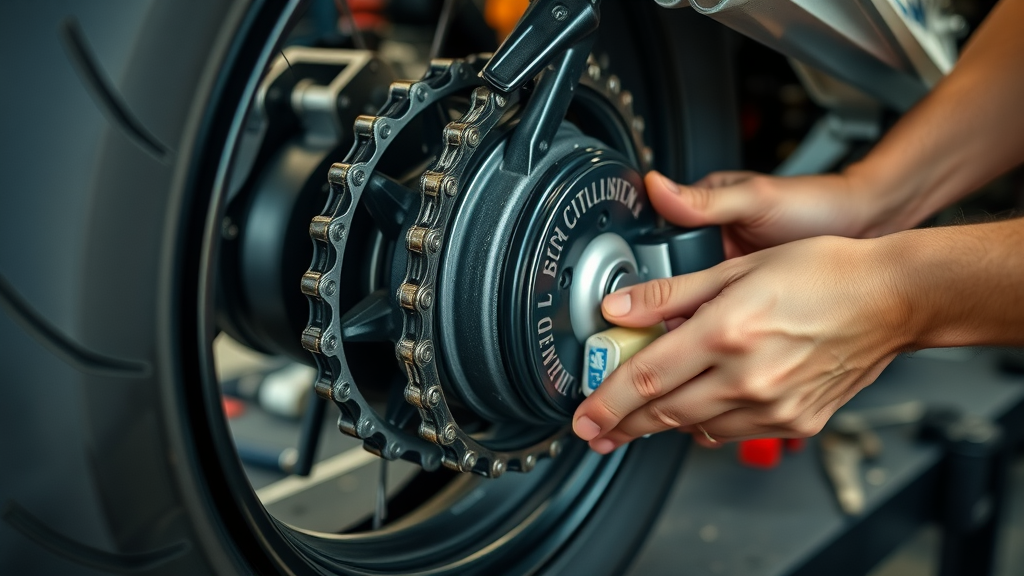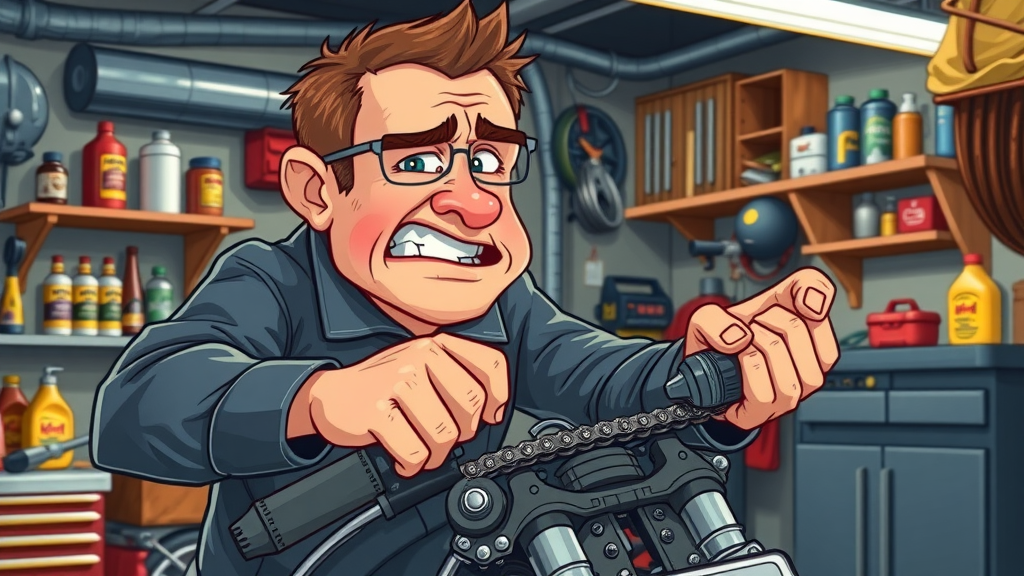Are you risking your ride’s performance—and safety—by ignoring crucial chain lubrication tips? Many motorcycle owners unknowingly shorten their bike chain’s life, experience sluggish gear changes, and spend more on repairs than necessary because of improper chain care. This guide demystifies chain lubrication tips every rider should know. Whether you’re new to motorcycles or an experienced rider, keeping your chain in peak condition is the fastest way to enjoy smoother rides, more power, and fewer mechanical headaches.
Dive in to uncover time-tested techniques, discover the most effective lubricants (yes, there’s more than one type!), and avoid the costly mistakes even seasoned riders make. Ready to transform your motorcycle chain’s performance—and your peace of mind?

Are You Guilty of Overlooking These Essential Chain Lubrication Tips?
Every motorcycle owner, from adventure bikers to city commuters, depends on the health of their bike chain for reliable rides. Yet, chain care is often skipped or rushed, leading to premature chain wear and costly breakdowns. Understanding and implementing effective chain lubrication tips can be the difference between a smooth ride and a breakdown miles from home. For example, many riders mistakenly believe that a quick spray with WD-40 or a dab of generic oil is enough—when in reality, improper technique and poor product choices leave rollers and chain links unprotected from dirt, friction, and rust.
Consider the difference proper lubrication makes when accelerating onto a freeway or downshifting on a twisty mountain road. The rear wheel transfers power more efficiently, while the chain lube acts as a cushion, reducing stress on every link. More importantly, using correct procedures and intervals extends the life of not only your motorcycle chain, but also your rear sprocket and transmission parts, keeping your machine safer and your wallet happier. If you’ve ever heard a squeak or felt a jolt from your chain, it’s time for a chain care makeover using proven motorcycle chain maintenance strategies outlined here.
Unlock Your Motorcycle Chain’s Full Potential with Effective Chain Lubrication Tips
-
Critical chain lubrication tips for extending chains’ lifespan and boosting performance
-
How to choose the right motorcycle chain lube and bike chain maintenance frequency
-
The difference between dry lube, gear oil, and modern motorcycle chain lubricants
-
Safe, step-by-step methods to properly lubricate the chain on any motorcycle
-
Common myths (like using WD-40 or vaseline) explained by experts
Understanding Why Chain Lubrication Tips Matter for Every Motorcycle Chain
The foundation of every trouble-free ride is a well-cared-for motorcycle chain . Why is this seemingly simple component so crucial? Every mile you travel causes the chain’s links and rollers to flex, rub, and interact with grit or moisture. Over time, without proper chain lube , friction wears down vital parts of the ring chain and can cause chain and rear sprocket misalignment. Even the toughest O-ring or X-ring chains require regular maintenance to seal out dirt and keep lubricant inside the tiny spaces where it matters most.
Neglecting routine lubrication doesn’t just invite rust; it causes increased drag, robbing your motorcycle chain of efficiency and risking sudden failure under hard acceleration. Seasoned riders know that a noisy or stiff chain is your bike’s way of calling out for help, and proper lubrication silences those complaints while boosting the lifespan of your whole driveline. If you’re aiming for maximum performance and safety, integrating expert chain lubrication tips into your maintenance schedule is non-negotiable—no matter how modern or rugged your motorcycle.

“A well-lubricated motorcycle chain isn’t just about performance—it’s your best insurance against breakdowns and costly repairs.”
Choosing the Right Chain Lube: Which Lubricants Give Your Motorcycle Chain an Edge?
With dozens of options on the market— dry lube , specialty chain lube products, even old-school gear oil —it’s easy to feel overwhelmed when shopping for the right chain lubricant . Your ideal lube will depend on the type of bike, where you ride, and how often you maintain your chain. For instance, dry lube is preferred for mountain bikes and off-road motorcycles operating in dusty terrains, as it resists sticking to dirt but requires more frequent applications. By comparison, chain lubes designed for motorcycles offer superior adhesion and weather resistance, making them the go-to for modern street and performance bikes.
But what about gear oil —a favorite of classic-bike purists and older motorcycle owners? It’s cost-effective and provides satisfactory lubrication, but can be messier and more prone to flinging off at high speeds, causing unwanted grime to accumulate on the chain and rear sprocket . A carefully chosen lube of choice ensures your ring chains last longer, resist corrosion, and provide the smooth, quiet performance every rider craves. Understanding these differences is the first step to picking the lube that lets your chain perform at its best.
Comparing Gear Oil, Dry Lube, and Specialty Chain Lube Products
|
|
|
|
Comparison of Common Motorcycle Chain Lube Options |
|
Lubricant Type |
Pros |
Cons |
Use Cases |
|---|---|---|---|
|
Dry Lube |
Clean, less dirt |
Less lasting |
Off-road or dusty areas |
|
Gear Oil |
Cost effective |
Can fling, messy |
Older motorcycles |
|
Chain Lube |
Designed for chains |
Price |
Daily or performance bikes |
Step-By-Step Chain Lubrication Tips: How to Lubricate the Chain for Maximum Performance
Proper application of your preferred chain lubricant is just as important as the product you select. Each step from cleaning to setting the lube helps ensure maximum absorption and minimal chain wear . If you’re using a rear stand or center stand, you’ll gain easy rotating access, but even without one, methodical care ensures all chain links are evenly lubricated. Here’s a five-step process that balances efficiency and thoroughness for any motorcycle chain or bike chain .
Start by choosing a clean rag and a quality degreaser to remove built-up grime and old chain wax . This foundational cleaning restores the integrity of your ring chain’s surfaces and allows fresh lube to penetrate rollers and pins where it matters most. Skipping cleaning, or applying new lube on top of old, can trap dirt and speed up chain wear—so always prep carefully before you lubricate your chain.
-
Clean the motorcycle chain thoroughly with a suitable degreaser.
-
Rotate the rear tire for even chain access.
-
Apply the chain lube or preferred lubricant evenly on the chain’s inner links.
-
Wipe off any excess chain lube.
-
Allow lubricant to set before riding.

Expert Recommendations: Best Practices for Maintaining Your Bike Chain
Experts emphasize maintaining a regular routine and adapting it to your riding style and environment. Consistency is vital: lube your chain every 300-600 miles, or sooner if you ride in wet or dusty conditions. Always clean before reapplying lubricant; old grime can interfere with new lube and accelerate chain wear . Use a clean rag to wipe the chain after lubrication—removing excess lube prevents gunk build-up around the chain and rear sprocket , which can lead to stiff links and damaged rollers of the chain .
After lubing, give your chain 15-30 minutes to allow the product to penetrate the links and rollers . Avoid riding immediately, especially with sticky or heavy chain lubes . Lastly, check tension and alignment as part of your routine; a well-lubricated but misaligned chain risks uneven wear and safety hazards. These habits, paired with being attentive to unusual noises or resistance, will keep your bike chain reliable, safe, and ready for your next adventure.
Common Mistakes in Chain Lubrication Tips: What Motorcycle Owners Get Wrong
Even diligent riders sometimes slip into bad habits or rely on outdated advice when caring for their motorcycle chain. A classic mistake is over-applying lubricant—thinking more is better—when in reality, thick coats can trap abrasive dirt, leading to fast chain wear and sticky buildup on the rear wheel. Another frequent misstep is using the wrong product: household oils, grease, vaseline , or even WD-40 are sometimes substituted for specialty chain lube , but these can degrade O-rings and attract damaging grit.
Cleaning shortcuts, such as simply spraying over old grime without degreasing, are equally risky. Dirt and spent lube combine into an abrasive paste that eats away at your valuable ring chain . Lastly, ignoring lubrication altogether during rainy or dusty rides is one of the fastest ways to see corrosion, rust, and mechanical symptoms that can be expensive to resolve. Avoid these pitfalls by sticking to the expert-backed chain lubrication tips in this guide.

-
Over-applying chain lube or ignoring the recommended intervals
-
Using the wrong products, such as vaseline or WD-40
-
Failing to clean the motorcycle chain before lubrication
-
Skipping lubrication during wet or dusty riding conditions
“Ignoring even basic chain lubrication tips can cut your motorcycle chain’s life in half.”
Watch this step-by-step walkthrough of proper motorcycle chain lubrication, presented by expert mechanics. Includes real close-ups of cleaning, applying chain lube , and pro tips for maximum performance.
Pro Insights: Advanced Chain Lubrication Tips for Bike Chain Longevity
With experience comes in-depth understanding of how climate, riding intensity, and terrain affect chain life. Pro riders often increase chain care frequency in moist or muddy conditions to prevent rust and minimize grit in the rollers. Switching lube types as the seasons change—such as using heavier chain lube for rainy weather or dry lube during summer’s dust—can net you extra months of smooth, low-maintenance performance. Don’t overlook the details: always check ring chains for signs of stiff links or missing O-rings and give special attention to the chain and rear sprocket contact points.
Inspecting your motorcycle chain after off-road rides or long highway stretches, and performing a quick touch-up with your lube of choice, foils rust and beads away moisture before damage sets in. Advanced maintenance—like rotating the chain during application, cleaning the chain and rear sprocket, and carefully removing all excess lube —translates directly into longer intervals between replacements and a more confident, quieter ride.

Frequency & Environmental Factors: Adapting Your Chain Lube Routine
The golden rule of chain care is flexibility: there’s no single interval that suits every rider. If you’re a daily commuter facing city grime, a weekly clean and re-lube might be ideal. Dirt bikers or adventure riders should check the bike chain after every off-road session, while fair-weather riders might stretch intervals to every 600 miles. Crucially, always lubricate after riding in rain, through puddles, or on dusty trails—water and grit strip away lube faster than you think.
Watch for clues that it’s time to lube your chain, including extra noise, rust spots, or visible dryness. Environment—urban, rural, or mountain—should guide your maintenance habits. For example, riders near the ocean or in humid climates should use anti-corrosive chain lubes and check for rust more often. Adapting your maintenance schedule to these factors is the best investment you can make in your motorcycle chain’s long-term health.
Video Demonstration: Comparing Chain Lube vs Gear Oil vs Dry Lube on a Real Motorcycle Chain
This visual comparison shows how chain lube , gear oil , and dry lube perform on actual motorcycle chains. See real-time results for application, dirt attraction, and durability—helping you decide which lube wins for your riding needs.
People Also Ask: Essential Answers About Chain Lubrication Tips
How to properly lubricate a chain?
To properly lubricate a chain, first thoroughly clean the motorcycle chain using a degreaser and a clean rag. Rotate the rear wheel so you can access every link. Apply your chosen chain lube along the chain’s inner side, aiming to reach the rollers and links. Wipe off any excess lube to avoid grime buildup and give the lubricant 15-30 minutes to set before riding. This process ensures even distribution, reduces chain wear, and boosts both safety and performance.
Step-by-Step Process for Proper Motorcycle Chain Lubrication
1. Put your motorcycle on a center or paddock stand.
2. Use a suitable chain cleaner and brush to remove old grime.
3. Dry the chain with a clean rag.
4. Slowly rotate the rear wheel while applying chain lube to the inner side.
5. Wipe off any excess lube, especially on the outside of the chain, and let it set.
This step-by-step approach guarantees your bike chain remains supple, rust-free, and ready for any adventure.
Is WD-40 good for chain lubrication?
WD-40 can serve as a cleaner but is not ideal as a primary motorcycle chain lubricant. While it can loosen dirt and old lube, it lacks the staying power needed to handle the high stresses, speed, and heat experienced by modern motorcycle chains. Stick to motorcycle-specific chain lubes for long-term protection and to prevent rust, friction, and premature chain wear.
Expert Verdict: Should You Use WD-40 for Your Motorcycle Chain?
Experts generally recommend using WD-40 only for cleaning a chain, not as a lasting lubricant. Its formulation doesn’t provide the viscosity or protective barrier needed for sustained riding, especially on O-ring or X-ring chains. For lubrication, always select a product specifically manufactured for motorcycle chains to ensure safety and optimal performance.
Can I use vaseline as a chain lubricant?
Vaseline is not advised for motorcycle chains. Although it offers some short-term lubrication, vaseline attracts dirt and wears away quickly at riding speeds, failing to protect inner rollers and rings. Using it may accelerate chain wear and could damage vital seals on ring chains. Choose purpose-made chain lubes instead for reliable results.
Why Vaseline Is Not Recommended for Bike Chain Lubrication
The thick, sticky nature of vaseline might seem helpful, but it becomes a magnet for debris. On moving chains, especially at high speed, its protective properties break down more quickly than intended, leading to increased friction and eventual chain and rear sprocket damage. For best results, always use a product engineered for motorcycle chain maintenance.
What is the best lubricant for a chain?
The best lubricant for a chain usually depends on your riding style and climate. For everyday and performance riding, motorcycle-specific chain lubes offer long-lasting protection, penetration, and weather resistance. In dusty conditions, dry lube minimizes dirt pickup, while gear oil—used traditionally—serves older, non-ring chains well but can be messier. Always choose high-quality, specialized chain lubricant for maximum longevity and safety.
Choosing the Best Chain Lube Option for Your Motorcycle
When selecting chain lube, consider environment, frequency of use, and chain type. Modern chain lubes, especially those marked as O-ring or X-ring safe, are ideal for high-performance or daily motorcycles. Dry lube is better when riding in dusty or arid regions, while gear oil remains a budget-friendly option for vintage or secondary bikes. Consult your owner’s manual or a trusted mechanic if unsure.
Frequently Asked Questions About Motorcycle Chain Lubrication Tips
Should I lubricate the chain after every ride?
While lubricating after every ride is unnecessary for most riders, you should reapply chain lube after riding in wet or muddy conditions. For typical use, lubrication every 300-600 miles is effective. Always clean before re-lubricating and adjust frequency based on your riding habits and local environment.
What happens if the motorcycle chain is over-lubricated?
Over-lubricating can trap dirt and debris against the chain, causing abrasive wear, residue buildup, and sticky links. Excess lube also slings off onto the rear wheel and sprockets, creating a mess and potentially causing safety hazards. Apply just enough lube to cover the internal rollers and wipe away the rest.
Can I mix different types of chain lube?
Mixing different types of chain lube is not recommended. Residues from incompatible products may gum up or degrade the performance of new lubricant. If switching types, thoroughly clean the motorcycle chain to remove all old lube before applying a different formulation.
Key Takeaways from Essential Chain Lubrication Tips
-
Regular cleaning and proper chain lubrication extend your bike chain’s life
-
Choose the right motorcycle chain lube for your conditions
-
Avoid shortcuts like vaseline or WD-40 except for cleaning
-
Consistent maintenance enhances safety and performance
Ready to Transform Your Motorcycle Chain with Expert Lubrication Tips? Call Us Today: 847-458-4858
Don’t leave your bike’s performance to chance—adopt these chain lubrication tips and enjoy every mile with confidence and safety. For personalized maintenance help or to order professional-grade products, call us at 847-458-4858 today!
Maintaining your motorcycle’s chain is crucial for optimal performance and longevity. For a comprehensive understanding, consider exploring the following resources:
-
“How Often Should You Lube Your Motorcycle Chain?” ( us.haynes.com )
-
“Complete Motorcycle Chain Maintenance in 8 Steps” ( blog.rad.eu )
These guides offer detailed insights into proper chain care, including cleaning techniques, lubrication intervals, and maintenance schedules. By following their expert advice, you can ensure a smoother ride and extend the life of your motorcycle’s chain.
 Add Row
Add Row  Add
Add 



Write A Comment